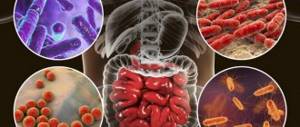Causes of yellow stool in adults
Just like green stools can be caused by increased consumption of green foods, yellow stools can be caused by increased consumption of foods containing yellow or orange dyes, which are carotenes. They occur, for example, in carrots. This phenomenon, of course, is not dangerous and short-lived.
Otherwise, yellow stool is not normal. Let us remember that when we have yellow stool or light-colored stool, it may mean that our stomach, liver or colon has been attacked by a serious disease. Yellow stool can signal:
When yellow stools also smell very bad, with mucus in them, the cause may be a malabsorption of fats, that is, problems with the thyroid gland. In addition to inflammatory diseases, symptoms also accompany celiac disease or cystic fibrosis.
- Celiac disease, that is, gluten intolerance, should not give obvious symptoms in early childhood. Often diagnosed only in adults, based on a small intestinal biopsy performed for nonspecific symptoms (malnutrition, colic, excessive gas, and even behavioral disturbances).
- Cystic fibrosis is diagnosed in early childhood (and more and more often, fortunately, already in newborns, thanks to examination), due to very serious diseases of the digestive system (for example, chronic diarrhea), as well as breathing (bronchitis, sinusitis, symptoms, close to asthma). It happens, however, that the doctor focuses on symptoms and diseases that are only a consequence of this disease.
Sudden yellow diarrhea often indicates a bacterial infection of the intestines.
Yellow stools, like gray stools, are also accompanied by liver diseases and may be associated with improper secretion of bile.
Diseases of the gallbladder, disorders of the bile ducts and liver diseases
All three reasons can be combined, since they have one consequence - lack of bile in the intestines. And a lack of bile leads to digestion problems. Undigested fats obtained from food may contain such an important component as essential fatty acids, which play an important role in the functioning of cells. But these fats cannot be digested and therefore leave the body unchanged. And poorly digested food leads to damage to the wall of the small intestine, the development of inflammation and impaired absorption of nutrients obtained from food.
Without bile, some vitamins cannot be absorbed, namely A, D and E. Without vitamin A, good vision is impossible, especially at night. A deficiency of this vitamin leads to consequences such as exhaustion of the body, dry skin, and the development of eye inflammation.
It is worth noting that the appearance of yellow feces is often associated with this group of diseases, or more precisely, with liver diseases (hepatitis, cirrhosis). Therefore, you should not ignore this symptom and, if possible, seek qualified medical help.
Very light stool - the main reasons
Brown stools are the result of bile salts secreted by the liver. If their production decreases, the stool is light in color. Another reason may be taking medications containing aluminum hydroxide. The stool may be temporarily light-colored after medical examination using barium sulfate.
Light-colored stools may be clear or gray, float, and may have a foul odor caused by fat in the stool.
Hard stools occur when the contents of food consumed through the digestive tract slow down, which is typical in the case of the passage. This may be the result of a lack of fiber in the diet and lack of fluids.
And loose stools are caused by accelerated consumption of food through the intestines, characteristic of diarrhea.
Treatment of light yellow stool in adults
A gastroenterologist deals with diseases of the digestive system. If there is mucus in the stool, bloating, gas and constipation, then you should drink more water and eat foods that help remove mucus. Products that create a smooth film on the intestinal mucosa, such as flaxseed, are soaked overnight in water before consumption.
In order to prescribe effective treatment, you must first find out why the stool is light yellow in color in an adult, establishing the true reasons by taking a bacterial culture test.
- flour dishes;
- carbonated products;
- fried and smoked.
You should follow a diet that includes only fresh and healthy foods. Sometimes dairy products can cause bloating and heaviness in the stomach. Therefore, their consumption should be limited.
For stomach pain, you can brew chamomile. It should be taken 3 times a day. The herb has antibacterial and antispasmodic properties.
If you experience pain in the abdominal area during light yellow stool, you can take no-shpa or any painkiller.
Frequent light-colored stool may indicate the presence of a bacterial component. In this case, you should definitely consult a qualified specialist.
An unexpected change in the color and character of stool in both an adult and a child in most cases causes concern. Moreover, if in some situations a changed color may indicate the consumption of certain products, then sometimes it can also indicate the presence of certain diseases in the body.
Often the cause of health concern in adults is the appearance of yellow stool. In this case, panic is not without meaning, because in some situations such a symptom may actually indicate the development of pathological processes in the body.
Possible complications
Yellow stool along with other symptoms can lead to: low blood counts, dehydration, eating disorders, growth problems in children, cancers or infections.
Some symptoms, along with yellow stools, indicate problems with the digestive tract:
- Diarrhea
- Nausea and vomiting
- Upset stomach and gas
- Bad stool odor
- Bloating
- Abdominal cramps
In rare cases, there may be complications with yellow stool: jaundice, fever, general fatigue, itching, joint pain.
A change in the usual brown shades of stool to lighter ones makes us think about digestive disorders. Why did the stool become lighter? Is yellow stool serious or not? Let's talk about this in more detail.
Causes of yellow stool in adults
In most cases, bilirubin is responsible for the appearance of yellow stool. Normally, this element promotes the release of stercobilin, which gives human feces the usual reddish-brown color.
If the body does not produce enough of this substance, feces lose their color and an unpleasant yellow tint may appear.
Under such circumstances, liver disease such as hepatitis or cirrhosis is usually suspected.
However, with such diseases, in most cases, the feces acquire a light yellow tint, and after a while they finally lose their color and become white or slightly grayish. If an adult has bright yellow stool, most likely we are talking about completely different ailments.
As a rule, yellow stool in an adult is caused by the following reasons:
- the most banal and harmless reason is eating large amounts of fresh milk;
- disruption of the digestion of carbohydrates or fermentative dyspepsia;
- pancreatic insufficiency;
- poor digestion of food in the large intestine.
All these reasons are not associated with serious diseases of the human body, but in some cases require treatment under the supervision of a gastroenterologist. If diarrhea is added to the unusual color of the stool, most likely we can talk about the presence of rotavirus infection.
In addition, the following factors can cause loose yellow stool in an adult:
- diabetes mellitus and other thyroid disorders;
- hormonal imbalance in women associated with the onset of menopause, pregnancy and other reasons;
- intestinal upset caused by long-term use of antibiotics or other medications;
- severe nervous tension, severe stress, excessive anxiety, pathological depression and other neurological problems;
- Also, periodic yellow diarrhea can occur in the presence of chronic ailments of the digestive tract, for example, stomach ulcers, gastritis, pancreatitis, and so on. If at the same time the processes of rotting and fermentation of the food consumed are actively occurring in the body, the feces may acquire a yellow-green tint;
- lack of bile salt in the body;
- rehabilitation period after surgery on the gastrointestinal tract.
All of the above reasons can cause a change in the color of an adult's stool from light yellow to yellow-green. Despite the fact that some of these factors do not cause any particular harm to the body, and stool independently acquires its usual color within a few days, in some cases the help of a specialist may be required.
Unhealthy gut?
Among the intestinal causes that lead to changes in the color of stool in an adult, Crohn's disease stands out. This is an autoimmune disease in which ulcers form in the intestinal mucosa. Crohn's disease is characterized by yellow-gray mushy stool, often foul-smelling with white flecks. If you see balls or lumps in white stool, and the stool is formed, then the reasons for such inclusions may also be:
- inflammation of the colon (mucus with white inclusions);
- antibiotics;
- candidiasis (veins of fungal colonies resemble a whitish coating);
- dead pinworms.
When should you see a doctor to treat yellow stool in an adult?
Treatment for yellow stool directly depends on the reason for the change in color.
- Of course, first you should adjust your diet and completely eliminate milk and dairy products from it for a while.
- Also, if possible, you should stop taking all medications for at least a few days to see how your stool reacts.
- If the situation does not change within a week, you should consult a doctor for a detailed examination.
A qualified doctor will ask you to take the necessary tests and, based on their results, will identify the true cause of yellow stool in an adult and prescribe appropriate treatment.
In addition, if bright yellow stool is accompanied by persistent loose stools, fever, nausea and vomiting, general weakness, malaise and excessive drowsiness, you should seek medical help immediately.
If such symptoms are present, it can be assumed that an infectious process is developing in the body, as well as severe inflammation in the intestines, stomach or gall bladder.
All these conditions can be very dangerous for humans, as they can provoke severe complications, including death. Don't ignore the signals your body gives you if you want to stay alive and healthy.
The materials posted on this page are informational in nature and intended for educational purposes. Site visitors should not use them as medical advice. Determining the diagnosis and choosing a treatment method remains the exclusive prerogative of your attending physician.
Similar articles
Lipomas (popularly called wen) are benign tumors located directly under the skin and consisting of adipose tissue.…
Children are the most fragile and unprotected creatures from external factors. Any parent who sees a rash on their child’s face or body will raise the alarm. Papilloma in...
Today, the problem of immunodeficiency in people is very relevant. Every day there are more and more diseases that are viral in nature. For similar diseases...
Of course, parents pay a lot of attention to their children and care about their health. If any spot appears on a child’s body, they notice immediately. But…
You don’t even need to be a qualified doctor to be able to determine the health status of any person by his appearance. But at the same time there are...
An unusual color of stool can alert a person who cares about their health and become a reason to consult a doctor. The first assumption when yellow stool appears is that there is a problem with the liver. The dark yellow color of feces usually does not bother you, but the light yellow color of feces is most often a sign of trouble in the gastrointestinal tract.
The normal composition of the solid fraction of feces is:
- 30% - undigested food;
- 5% - protein.
30% - bacteria;
15% - inorganic substances;
The color of stool depends on the number of bacteria present in the human body at the time of stool formation.
Symptoms
If, in addition to lightening the stool, you feel unwell and a deterioration in your general condition, you should seek medical advice. Especially if you eat, the malaise does not go away within a day. Symptoms to watch out for:
- persistent increase in temperature;
- stool disorder;
- nausea, vomiting;
- pain in the abdomen, left hypochondrium, girdle pain;
- yellowed sclera of the eyes and skin;
- lack of appetite;
- sudden weight loss;
- dark urine;
- flatulence, abdominal enlargement;
- stool with mucus.
If there are at least two additional signs with light-colored stool, it is necessary to undergo a medical examination to determine the diagnosis. With some problems, for example, with advanced pancreatitis, the count is not days, but hours. Be attentive to symptoms and do not ignore serious ailments.
Factors influencing the appearance of yellow stool
Stercobilin, a derivative of bilirubin, gives stool a typical red-brown hue. If there is not enough stercobilin in the body, the stool becomes yellow. The main reason for low stercobilin levels is a deficiency of bilirubin due to stool passing too quickly through the intestines or due to too much feces. Bilirubin is produced in the liver as a result of the conversion of hemoglobin, which moves oxygen from the blood to the internal organs. If pathological processes occur in the liver, much less is produced than normal.
Factors influencing changes in stool color:
- Liver diseases.
Liver diseases such as cirrhosis and hepatitis (as well as gallbladder disorders) can reduce the amount of bile salts produced in the body. The combination of yellow stool with a change in its consistency is a sign of a deficiency of bile salts in the body, infection, or impaired liver function.
A yellowish stool can also be caused by a virus, autoimmune or. Most often these changes are caused by a viral infection. Yellowing of the stool is caused by a disease, the symptoms of which are detected after a blood test.
Diseases of the pancreas.
Conditions such as cystic fibrosis and a blocked pancreatic duct can cause yellow or pale stools.
A pale yellow tint to feces may appear after eating large amounts of fatty foods for a long time. In this case, the feces acquire an extremely unpleasant odor. This reaction of the body to fatty foods may indicate a dysfunction of the pancreas.
Celiac disease.
If a person who is sick eats gluten (the protein in wheat, rye and barley), their immune system attacks this undigested protein, including the tissue of the small intestine, damaging it and impairing the ability to absorb nutrients.
According to the National Celiac Disease Foundation, more than 300 different symptoms are associated with celiac disease. This makes diagnosis difficult.
Yellow products.
Carrots (especially fresh carrot juice), sweet potatoes, turmeric and other yellow foods can turn your stool yellow. If you regularly have yellow stools due to your diet, then you should avoid fatty and processed foods, as well as gluten. In addition, yellowing of the stool may be a side effect of taking medications with a high content of β-carotene.
A change in the color of stool from green to yellow can be observed when the intestines are infected, because the rate of transport of digested foods through the intestines in this case is extremely high. In this case, the feces do not have time to acquire their usual color. Another reason why stool turns yellow is a deficiency of bile in the body.
Gastrointestinal disorder
The causes may be diseases such as:
- Impaired intestinal motility, which is caused by eating large amounts of fatty and heavy foods, uncontrolled use of laxatives, intestinal inflammation, intestinal infections, as well as constant and excessive nervous tension.
- Complete or partial impossibility of the outflow of bile from the gallbladder due to the presence of stones in it, benign/malignant tumors of the liver or gallbladder, or previous surgical interventions.
- The inability to secrete pancreatic enzymes due to blockage of the ducts in diseases such as cystic fibrosis, a genetic disorder that affects the endocrine glands, or tumors of the pancreas.
When should you see a doctor?
Before seeking medical advice, you should look for the causes of yellow stool that can be analyzed independently. First, you need to make changes to your diet and give up milk and dairy products for a while. If you are being treated with any medications at this time, it is advisable to stop taking them for a few days to see how your stool reacts to such changes.
Only after 5-7 days of staying in this mode is it worth contacting a gastroenterologist for diagnostics. The doctor will prescribe tests and, based on the data obtained, determine treatment tactics.
If yellow stool is accompanied by frequent diarrhea, fever, weakness, and drowsiness, you do not need to wait several days, you should get emergency help. It is possible that the cause of such symptoms is infection or inflammation of the intestines, gallbladder, or stomach. Such conditions can cause death and serious complications, so you should immediately get qualified help.
Liver dysfunction, which changes the color of feces to a light yellow tint, occurs after taking the following drugs:
- Medicines for the treatment of tuberculosis;
Antibacterial agents;
Oral contraceptives;
Methotrexate;
Paracetamol;
If such side effects occur, the patient needs to consult a medical professional. If the light yellow color of stool is not caused by side effects of medications or gastrointestinal diseases, after 2-4 days it will return to normal, changing its color to a red-brown hue. In a normal state of health, there will be no signs of trouble.
Signs of the disease when combined with light yellow stool:
- Hyperthermia,
Dark urine
Yellow skin tone.
Loss of body weight,
Decreased appetite
Pronounced putrid odor of feces.
Yellow feces in adults are most often unusual. You need to start looking for explanations for the change in color of a person's stool from normal brown to pale yellow, yellowish or bright yellow.
Accurate diagnosis
Differential recognition of the disease is only possible using imaging techniques. The latter include ultrasound, CT, MRI, and radiography. An auxiliary method is a blood test for tumor markers, general, biochemical, to determine the acid-base environment. In the presence of organic pathology, the diseased structure may appear swollen and enlarged. In case of functional disorders, there are no visually noticeable changes. In such a situation, the diagnosis is made on the basis of laboratory examinations and samples.
What does a change in stool color indicate?
Normally, an adult's stool is brown in color. But if the body is not functioning correctly, the color of the stool may change to light, white-yellow, clay gray, earthy, yellow-green, green-gray, sandy, tan, orange, dark orange, red or black. Multi-colored feces are not the norm, but they are quite rare; the most common color of altered feces is yellow.
Yellow poop in adults appears due to insufficient intake of the enzyme stercobilin, which is responsible for coloring poop, into the intestines. What color the stool will come out depends on the stercobilin produced by the liver; the less of it, the lighter the stool, and the more, the darker.
Yellow feces may be a reason to consult a doctor if the problem really lies in the malfunction of the liver, gall bladder, or pancreas - the organs responsible for the production of enzymes for digestion.
It will be difficult for an inexperienced person to determine the disease by color, but a specialist will immediately outline a “circle of suspects.”
There is an option that an adult’s stool has changed to light-colored for natural reasons, which means there is nothing to worry about. But similar reasons for the appearance of yellow or yellow stool will be discussed below.
One of the main causes of constipation and diarrhea is the use of various medications
.
To improve bowel function after taking medications, you need to drink a simple remedy
...
Changes in the amount of stool passed
Fluctuations within the normal range can quite naturally arise as a reaction of the body to the foods consumed; the more plant food, the more feces; animal food, the less mass of excreted feces.
But if the deviations differ significantly from the norm, then this may indicate serious violations.
And so, a large amount of feces (polyfecal matter) is a sign of one of the following disorders:
- problems with the absorption of nutrients in the small intestine;
- violation of peristalsis, in which food moves too quickly through the intestines and does not have time to be fully absorbed;
- dysfunction of the pancreas, as a result of which fats and proteins are not properly digested, thus developing chronic pancreatitis;
- lack of bile in the intestines, occurs with cholecystitis, cholelithiasis.
A small amount of feces is usually released when people have a lot of easily digestible food in their diet, a small amount of it, and also when there is constipation. The latter should also cause alarm and be a reason to seek medical help.
Harmless reasons
The color of an adult’s stool largely depends on external factors. The color of feces changes to yellowish, yellow-green, orange when:
- Eating large amounts of milk and lactic acid products.
- Increased content of adult peas and other legumes in the diet.
- Eating yellow foods - pumpkin, orange, carrots, persimmons, dried apricots, melon, yellow apples and pears.
- The predominance of bakery products in the diet, since they contain difficult-to-digest carbohydrates.
- Taking choleretic drugs.
- Antibiotic therapy.
- Treatment with anti-tuberculosis, anti-inflammatory drugs.
- Taking laxatives.
- Using oral contraceptives (birth control pills for women).
- Drinking large amounts of alcohol, especially if you drink frequently.
- Rapid movement of feces through the intestines (for some people, this feature of the body - rapid peristalsis - is the norm).
If the color of a healthy adult's stool suddenly changes from brown to yellow, and there are no other symptoms, then there is no cause for concern.
You just need to think carefully and choose from the list above which reason was the reason for the change in the color of the stool in this case. The normal adult body always reacts to such changes in the environment by changing brown stool to yellow.
If these changes in the color of stool are one-time and with a different diet, giving up alcohol and drugs, they return to normal, then everything is fine and there is no need to think about whether this is normal.
If yellow poop appears in an adult for these reasons, no specific treatment will be prescribed. The person himself understands what to do - switch to a different diet, stop drinking alcohol, finish taking medications, or change the drug. But if none of the above reasons apply, then you should think about what it means and target more unpleasant factors.
Pathologies affecting the color of stool
With various diseases, human stool may become completely yellow, or be light in color with bile.
Certain pathological conditions and diseases will affect the color of stool:
- Cystic fibrosis, acute or chronic pancreatitis, and other diseases of the pancreas.
- Weak functioning of the pancreas, expressed in the production of insufficient amounts of enzymes necessary for digestion.
- Hepatitis or cirrhosis of the liver.
- Fermentative dyspepsia.
- Compression of the bile duct (tumor of a neighboring organ or simply a pathological structure), causing stagnation of bile.
- Inflamed gallbladder.
- Biliary dyskinesia.
- Condition after removal of the gallbladder.
- Diabetes mellitus and other hormone-related diseases.
- Hormonal changes and temporary disruptions in the body during pregnancy, after childbirth or during menopause in women.
- Condition after surgery on any organs of the digestive tract.
- Chronic stomach disease - ulcers and gastritis.
- Crohn's disease causes total damage to the intestinal tract, due to which food is not fully absorbed and processed and the feces are discolored - clayey yellow.
- Nervous stress, especially with frequent mental fatigue.
Remembering what the normal color of an adult’s stool should be, you can immediately notice the slightest deviations and analyze what this change means. After all, changes in the color of feces depend on a lot, but if these are not harmless reasons (food, medications), then there is a possibility of developing a pathological process or even a disease from the list above.
It is impossible to start treatment without preliminary diagnosis. You should immediately consult a doctor if a problem with stool color bothers an adult for a long time.
Lack of digestive enzymes
Colorless or yellow-white feces are observed when the process of bile entering the intestines is disrupted. Moreover, the more serious the problem, the lighter the stool. Obstructions can be all the way from the gallbladder to the duodenum. Impaired bile expulsion occurs in the following cases:
- dyskinesia of the gallbladder (too strong or, conversely, weak contraction);
- constipation (creates tension in the intestinal wall, making it difficult to secrete bile);
- cholecystitis;
- condition after removal of the gallbladder (cholecysteectomy);
- stones in the gallbladder or its ducts;
- compression of the bile duct by the enlarged head of the pancreas (tumor, edema, inflammation) lying next door.
A characteristic combination of these disorders is light yellow stool and dark urine. This means that bilirubin, instead of entering the intestines, is absorbed into the blood and excreted in the urine.
After removal of the gallbladder, the control of bile flow is impaired, so some portions of stool may be lighter than others. With cholecystitis, as well as cholelithiasis, in addition to the discharge of yellow-white feces, sharp pain is observed under the ribs on the right side after alcohol or fatty foods.
When consuming a large amount of fats or their breakdown is impaired (decreased activity of the pancreas), we observe loose yellow feces with the presence of a gray coating. This type of fatty, oily stool is called steatorrhea. Undigested fat in the intestines envelops the food bolus and prevents enzymes from breaking down proteins and carbohydrates. Therefore, with steatorrhea, creatorrhea often occurs - insufficient digestion of muscle fibers. Feces with pancreatitis have a characteristic shade of gray-green color and are almost not washed off.
What to do?
Having noticed a change in the color of feces, an adult should not ignore this fact.
Definitely worth it:
- Analyze the possible causes of changes in the color of feces.
- Look and think about whether there were other oddities in the body’s functioning (nausea, reluctance to eat, vomiting, fever, etc.).
- Change your diet if this may be the likely cause of the change in stool color.
- If possible, stop taking medications. And if not, consult with the current specialist who prescribed them about the appearance of yellow stool, it could just be a side effect.
- If no visible causes are found, it is worth getting diagnosed at the hospital.
- Submit feces for coprogram and bacterial culture.
- Do an ultrasound of the liver, gallbladder, and pancreas.
- Donate clinical blood and biochemical blood.
Video:
After diagnosis, if the results leave much to be desired, you should contact a specialized specialist - a gastroenterologist. Next, he will prescribe treatment based on the established diagnosis.
Starting treatment on your own is contraindicated. The only thing an adult can do is balance the diet, give up bad habits and take unnecessary, non-vital medications (laxatives, sorbents, etc.).
Yellow feces do not always immediately bother an adult, but this is until other symptoms of the pathology appear. And then it becomes impossible not to react to a strange sign.
You should definitely visit a doctor if:
- Abdominal pain of any nature appeared.
- The abdomen is abnormally soft or hard.
- Yellow feces are pinkish in some places, that is, they contain blood.
- There is a light state of feces and at the same time dark urine.
- The feces are loose, sandy, and eventually cease to be formed at all.
- Nausea appears, sometimes even to the point of vomiting.
- Vomiting appeared like a fountain, especially richly yellow in color.
- The temperature began to rise, slightly, but did not fall for a long time.
- Weakness occurs.
- No desire to eat food.
Seeing a doctor with such symptoms is simply a mandatory step, otherwise you can bring the disease to its peak and your health condition to critical. An experienced specialist will help you understand the reasons for the appearance of yellow stool in an adult and tell you what to do in each specific case.
Every person knows what color of stool is normal for him, and notices when the excrement takes on an unusual color. Light-colored stool, both in a child and an adult, can indicate diseases that cannot be ignored in order to avoid serious consequences. It is important to pay attention to the symptoms that accompany changes in stool color.
Steps
Find out what the color of stool may indicate
- Note the black or red color of the stool.
Both of these colors can be a potential sign of problems with the digestive system. Both black and bright red stools can be a symptom of bleeding in the intestines or a sign of hemorrhoids.
- However, in some cases, medications and certain types of foods may cause changes in stool color. However, if you are concerned about this, consult your doctor.
- Look for white, gray or light-colored stool.
Bile plays the main role in coloring stool. Discolored stool indicates a lack of bile entering the intestines. This indicates a blocked bile duct, which is a serious problem that requires immediate medical attention. If you notice white or light yellow stool, be sure to consult your doctor.
Brown stools may indicate that your health is fine.
Although stool color can range from brown to yellow and even green and be considered normal in this case, brown is considered normal. The color of the feces should be approximately the same color as the color of a candy bar.
- The color of stool is formed as a result of complex processes in the gastrointestinal tract. Bilirubin is the end product of the breakdown of hemoglobin in humans. It is directly related to the color of stool.
Food dyes, leafy vegetables, and even beets can affect the color of your stool. There's nothing wrong with that. For example, green leafy vegetables such as kale or spinach can make your stool appear green, while beets, for example, can add a reddish hue. This is not a cause for concern, especially if you have recently eaten these foods.
- Only in rare cases can red stool be an indicator of serious intestinal problems. The causes of blood in the stool range from something as benign as gastrointestinal irritation or hemorrhoids.
Pay attention to what medications you are currently taking.
Many medications, such as vitamin supplements or prescription antidiarrheals, can cause changes in stool color. In this case, such changes are considered normal, since they are associated with the use of medications. Therefore, be sure to read the instructions, paying attention to side effects or special instructions for the drugs you take regularly.
- Taking iron supplements may cause your stool to turn green or black. Medicines containing bismuth, for example, can turn stool black.
In the first few days after birth, this is completely normal. So don't be alarmed if you see black stool in your baby's diaper. On days 2-4 after birth, the first stool looks like tar. This is meconium, which is a physiological norm. After this, the baby's stool will acquire a porridge-like consistency of gray-green color. .
- A breastfed baby's stool will be soft and green or yellow in color. This is considered the norm.
A bottle-fed baby's stool will likely be mushy and a different color than breastfed babies' stool. It will be darker. This is also considered the norm.
When to see a doctor
- Seek immediate medical attention if your stools are bright red or black.
Even if you think these changes are related to taking medications or eating certain foods, it is best to consult a doctor, as this color of stool may indicate gastrointestinal bleeding. If you notice blood in your stool or have heavy bleeding during bowel movements, contact your doctor as soon as possible.
- If your stool has turned bright red or black and you have recently taken antidiarrheal medications, eaten foods that can turn your stool red, or started taking a new medication, check with your doctor to make sure changes in stool color are not a sign of something serious. diseases.
- Remember that in very rare cases, stool color may indicate the presence of a serious illness.
In most cases, changes in stool color are associated with medical conditions that can be treated. In addition, you may simply need to change your diet. A change in the color of your stool is unlikely to be a reason to go to the emergency room. Don't give in to unreasonable panic.
- Review recent changes in your diet or side effects of medications you are currently taking if your stool suddenly changes color.
- Consult your doctor if this issue worries you.
Regardless of the reason, if you are concerned about the color of your stool or are concerned about changes in your digestion, consult your doctor. The doctor, after conducting the necessary examination, will be able to either prescribe the necessary treatment or reassure you, saying that your health is fine.
- Even if you feel embarrassed talking about this sensitive topic, it is important to consult with your doctor if you are worried about it. It is always better to play it safe and undergo the necessary examination.
- Consider what other symptoms you experience along with the change in stool color.
If the color change is associated with abdominal pain or diarrhea, for example, it may be a sign of an illness unrelated to a change in diet. If the change in stool color is associated with other unexpected symptoms, contact your doctor.
A clear change in stool color may indicate a health problem, but is not necessary. Sometimes it is just the effect of diet or medications taken. It is especially interesting why light yellow stool is constantly found in adults. The normal range for stool ranges from moderately light to very dark brown. The optimal indicator is feces that do not contain visible impurities, and its color partly reflects what was recently eaten.
Why is stool light in color: possible reasons
The stool of a healthy person consists of the remains of food consumed over the last 2-3 days. In normal condition, the color of feces varies from light brown to dark brown, the consistency is dense, there is no specific odor or foreign impurities. If you notice the appearance of unusually light-colored stools, you should not make hasty conclusions and panic. We need to identify possible causes. Changes in stool color are caused by:
- physiological processes;
- medications;
- various diseases.
In an adult
Discolored excrement in an adult is associated with eating large amounts of fatty foods. For example, sour cream or butter. At the same time, a change in the color of stool does not cause discomfort to a person. Review your diet, eliminate fatty foods and stick to it. After a few days, the stool returns to normal.
The lightening of feces is affected by taking medications. For example, antibiotics, antifungals, oral contraceptives. You should stop taking medications and contact your doctor to prescribe therapeutic measures. A great danger is a change in the color of the stool, accompanied by an increase in body temperature and pain of varying intensity in the abdominal area.
During pregnancy
The color of stool indicates the functioning of the liver and pancreas. During pregnancy, a woman's organs work under increased stress. Lightening of feces is associated with a pathological condition accompanied by a failure of the digestive process. The source of light-colored stool in pregnant women is dysbacteriosis or excessive use of multivitamin complexes. You should contact your doctor to prescribe the necessary treatment.
What disease can light-colored stool be a sign of?
Lightening of feces is caused by diseases that disrupt the normal functioning of the liver, pancreas and gastrointestinal tract. Try to evaluate how you feel. How has your health changed in recent days, weeks, months? Remember what illnesses you suffered in the recent past. If light-colored stool is associated with diseases, the following symptoms are often observed:
- general weakness;
- increased body temperature;
- stomach ache;
- yellow color of the skin and eye sclera;
- dark urine;
- nausea, vomiting;
- flatulence;
- loss of appetite and weight loss;
- unexplained increase in abdominal volume;
- skin rash.
If you notice an unusual change in the color of your feces, accompanied by a sharp deterioration in your health, immediately consult your doctor. He will give you a referral for tests, on the basis of which he will identify the cause of lightening of the stool and prescribe appropriate therapy. Ignoring your unsatisfactory condition is extremely dangerous; it can be a sign of serious diseases:
- . The development of inflammatory liver disease caused by toxic, infectious or alcohol poisoning is indicated by a tugging sensation, an upset stomach, and a yellow tint to the skin. Without treatment, the disease leads to cirrhosis of the liver.
- . Inflammation of the gallbladder is accompanied by acute abdominal pain, decreased appetite, increased body temperature, and nausea. Feces with cholecystitis have a liquid consistency, sometimes with remnants of undigested food.
- . Inflammation of the pancreas occurs as a result of poor diet, alcohol abuse, infectious diseases of internal organs and taking medications. The acute phase of pancreatitis is accompanied by cutting pain in the abdomen, vomiting, and diarrhea.
- Crohn's disease
. A chronic disorder of the digestive system, caused by allergic reactions, psychosomatic and infectious diseases, is manifested by lightening of stools, vomiting, increased body temperature, and the frequent appearance of blood in the feces. - . The development of malignant neoplasms on internal organs is asymptomatic. The first signs appear when the tumor reaches a certain size. Among the symptoms, doctors identify: pain in the abdominal cavity, constipation or diarrhea, vomiting, lack of appetite, and sudden weight loss.
Light brown stool
Human consumption of predominantly plant foods leads to lightening of feces. This is not a pathology and does not pose a risk to your health. With the accelerated passage of digestive masses through the colon, the stool becomes light brown in color. Introducing protein foods into the diet will normalize the functioning of the digestive tract.
Light green
Human feces acquire an unnatural hue due to excessive consumption of food dyes, which are found in large quantities in sweet water, alcoholic drinks, and sweets. Addiction to herbal preparations and dietary supplements leads to stools turning greenish. After giving up foods, the color of stool is restored within 3-5 days. In other cases, it is a symptom of diseases:
- Dysbacteriosis
. Violation of the intestinal microflora is accompanied by liquid feces with a specific putrefactive odor. - Acute enterocolitis
. Inflammation of the gastrointestinal tract in acute form is accompanied by diarrhea and vomiting. The stool has a green tint with traces of pus. - Infectious diseases of the gastrointestinal tract
are manifested by general weakness of a person, nausea, and increased body temperature. The stool turns light green and contains blood, pus, or mucus.
Treatment measures
Therapeutic therapy may be as follows:
- taking sorbents to remove toxic substances from the body;
- taking medications to restore water-salt balance and prevent signs of dehydration;
- taking probiotics to replenish the natural microflora in the body;
- the use of antimicrobial medications to normalize stool;
- the use of enzyme medications to restore the deficiency of substances.
Symptomatic treatment is ineffective. Self-medication is also not effective. Sometimes it can be extremely dangerous. For malignant neoplasms, patients are advised to undergo surgery.











